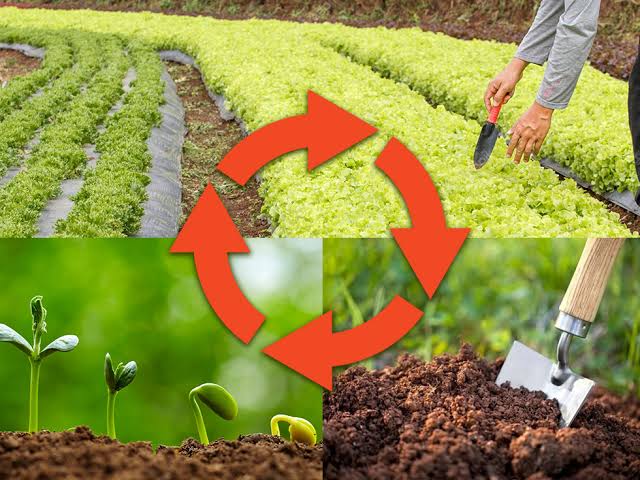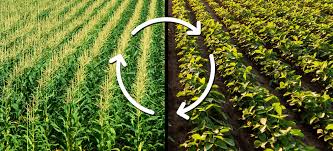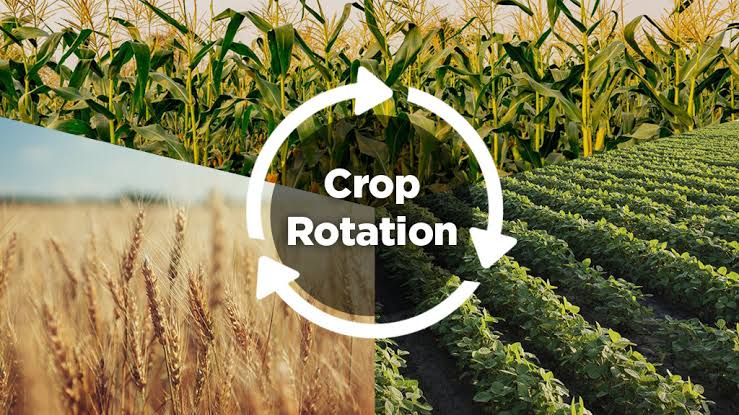Crop rotation is a farming practice that helps farmers grow healthier and more productive crops. It’s like changing the food on your plate so that you stay strong and healthy. In crop rotation, farmers change the crops they plant in a field each year. This simple method has been used for centuries and has many benefits.
Firstly, crop rotation helps to keep the soil healthy. If you always plant the same crop in the same field, the soil gets tired and sick. It loses important nutrients, and pests and diseases can make the soil their home.
Crop rotation is like a vacation for the soil. It gives the land a break from growing the same crop and helps it recover. This means the soil stays rich in nutrients, and crops grow better.
Secondly, it helps control pests and diseases. Just like people can get sick if they eat the same food all the time, crops can get attacked by pests and diseases when they are always in the same place.
When farmers change the crops in a field, it confuses pests and diseases. They don’t find their favorite food, and so they become weaker. This means farmers don’t need to use as many chemicals to protect their crops.
Thirdly, crop rotation can improve the taste of the crops. If you grow the same crop in one place for a long time, it might not taste as good. Crop rotation keeps the soil full of nutrients, and this makes the crops taste better. It’s like eating a variety of foods to enjoy different flavors.
Moreover, crop rotation is good for the environment. When farmers use fewer chemicals to protect their crops, it means fewer harmful substances go into the air and water. This helps keep our planet clean and safe.
Crop rotation also helps to save money. When the soil is healthy, crops grow better, and farmers get more food from their fields. This means they can sell more and make more money. It’s like getting a bigger allowance for doing your chores.
In addition, crop rotation is a smart and simple farming practice. It keeps the soil healthy, controls pests and diseases, improves the taste of crops, benefits the environment, and saves money. It’s a bit like changing your diet to stay strong and happy.
Farmers have known about it for a long time, and it’s something that helps us all by providing healthy and tasty food while taking care of the land.
Read Also: Introduction to Fisheries / Classes of Fish
The Process of Crop Rotation

Crop rotation is a method farmers use to grow different crops in the same field over a series of seasons. It’s like a dance for the plants, with each crop taking its turn in the spotlight. This process helps keep the soil healthy and prevents pests and diseases from getting too comfortable.
Here are the processes involved:
1. Planting the First Crop: To start, the farmer picks one crop to plant, like corn. They plant this crop in one field. The corn grows big and strong.
2. Switching to a Different Crop: After the corn is done, the farmer doesn’t plant more corn right away. Instead, they choose a different crop, like beans. They plant beans in the same field where the corn used to be. This is the switch part of crop rotation.
3. Helping the Soil: Different crops have different appetites. Corn might like certain nutrients while beans like others. By planting different crops one after the other, the soil doesn’t get tired of serving the same food all the time. It gets a chance to rest and rejuvenate.
4. Busting Pests and Diseases: Some pests and diseases are like party crashers. If they find their favorite crop every year, they will stick around and make life hard for the plants. But when you change the crop, it’s like changing the party theme. The pests and diseases get confused and may not show up.
5. Adding Nitrogen: Some crops, like beans, are like soil magicians. They can take nitrogen from the air and put it in the soil. This is like giving the soil a vitamin boost. When the next crop, let’s say carrots, comes along, they can use that extra nitrogen to grow better.
6. Repeat the Dance: The farmer keeps on switching crops like this, rotating them around the fields. It’s like a never-ending dance of planting and switching. This helps the soil stay healthy, full of nutrients, and free from nasty pests and diseases.
7. Harvesting and Enjoying: When each crop is ready, the farmer harvests it and enjoys the fruits of their labor. They have a variety of crops to eat, and the soil is happy too.
In a nutshell, crop rotation is like a choreographed dance for plants and soil. It keeps things interesting, ensures the soil is well-fed, and helps keep the bad guys (pests and diseases) away. It’s a win-win for farmers and the land they depend on.
Read Also: 8 Uses of Fish and Fish Products
Benefits of Crop Rotation

Crop rotation offers several benefits:
1. Improved Soil Health: Crop rotation helps maintain soil fertility. Different crops have different nutrient needs. By rotating them, the soil can replenish its nutrients naturally, reducing the need for synthetic fertilizers.
2. Pest and Disease Control: Rotating crops disrupts the life cycles of pests and diseases that are specific to certain crops. This reduces the need for chemical pesticides and protects the crops from infestations.
3. Weed Suppression: Some crops, like cover crops, can be included in the rotation to help smother weeds and prevent them from taking over the fields.
4. Increased Yields: Healthier soil, better pest control, and nutrient balance all contribute to increased crop yields. Farmers can harvest more from their fields, resulting in better economic returns.
5. Diversity of Produce: Crop rotation enables farmers to grow a variety of crops. This diversity in agricultural production can improve local food security, provide a range of products for markets, and reduce reliance on a single crop.
6. Sustainable Farming: Reducing the use of synthetic fertilizers and pesticides makes farming more environmentally friendly. It minimizes the impact on ecosystems, water quality, and the atmosphere.
7. Conservation of Natural Resources: By keeping the soil healthy, crop rotation helps in conserving the land for future generations. It prevents soil erosion and degradation, ensuring that the land remains productive.
8. Economic Stability: Crop rotation can help farmers spread their financial risk. If one crop fails due to adverse weather or disease, other crops in the rotation may still thrive.
9. Enhanced Soil Structure: Different crops have different root structures. Some crops, like deep-rooted ones, can break up compacted soil, improving its structure and drainage.
10. Carbon Sequestration: Certain crops used in rotation, such as legumes, can capture and store carbon in the soil, helping to mitigate climate change.
In summary, crop rotation is an essential practice in sustainable agriculture that offers a multitude of advantages, from healthier soil and increased crop yields to reduced environmental impact and economic stability for farmers. It’s a win-win for both agriculture and the environment.
Read Also: Management and protection of continental shelf and territorial Sea

